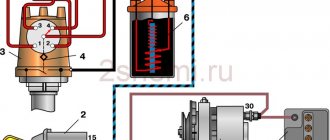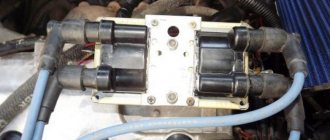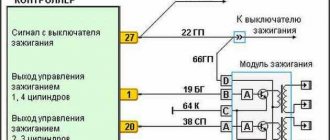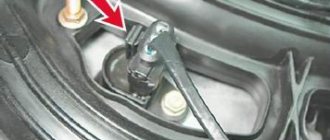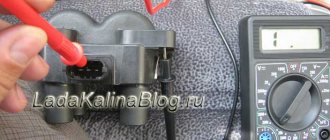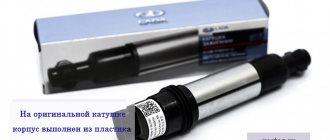The ignition coil of the VAZ 2112 engine is the main part of the car’s ignition system, which serves as a conventional low-voltage direct current converter, which comes from the battery or directly from the electric generator into high-voltage voltage for further supplying an electrical impulse to the spark plugs.
In today's article we will learn how to check the ignition module on an injection VAZ-2112 8 valve with our own hands, and also consider step-by-step instructions for replacing this car unit.
Replacing the coil with a 16-cl. engine
I think that there is no need to talk about the fact that VAZ 2110, 2111 and 2112 engines come in both 8 and 16 valves.
In previous articles we have already looked at the process of replacing a module with an 8-cell one. motor. Today we’ll look at the example of another power unit - 16V. On the one hand, this is convenient, and if one of them fails, you don’t have to change everything. On the other hand, maintenance is more expensive when replacing all these parts at once.
It’s quite easy to do the replacement yourself and for this you will need:
- socket head 10;
- extension;
- ratchet handle.
Possible malfunctions: signs and causes
Signs of a short circuit failure:
- when the driver presses the gas pedal, dips are felt;
- the power of the power unit decreases;
- the engine began to operate unstably at idle;
- the motor is shaking.
The main reasons why this can happen:
- Poor power supply in the car's electrical system. For normal operation of electrical components, a voltage in the on-board network of 11.5 volts is required. If the ignition wire is damaged or the battery performance is low, this may cause poor power supply. Accordingly, it will take more time to charge the short circuit.
- Mechanical damage to the device, for example, damage to the insulation. This problem may be caused by engine fluid entering the device through defective seals.
- Poor contact. Damage to the device, as well as constant exposure to moisture, can lead to failure of the primary and secondary windings, which in turn will contribute to the appearance of transition resistance. Such a malfunction can occur as a result of breakdowns in the washer system, washing the power unit, as well as heavy rain. Also, the structure of the device can be negatively affected by the salt that is sprinkled on roads in icy conditions.
- Thermal problems. Individual short circuits are more susceptible to high heat generation than others, which can also negatively affect the service life of the device.
- Working in vibration conditions. Due to high vibrations in engine operation, damage to the short-circuit structure may occur (video author - Resta channel).
How to check the ignition coil on a VAZ-2112 16 valves with your own hands
The ignition coil, which is located in the car, essentially converts the low voltage from the battery and generator into high voltage, to supply it individually to each spark plug. Roughly speaking, this is a miniature electrical transformer, the moment of failure of which is almost impossible to predict and repairs and diagnostics have to be carried out on the failed device. Below in our article we will tell you in detail how to check the ignition coil for a VAZ-2112 with your own hands.
The video describes in great detail the algorithm for checking the ignition coil on a VAZ-2112:
Typical module failures
If you have at least a little knowledge of electronics, as well as a multimeter, you can independently diagnose and identify the problem. Checking the VAZ-2110 ignition module will take a little time, but will save you from purchasing an expensive unit
Please note that sometimes races appear that disappear over time
Errors will remain in the microcontroller, so they can be read using special testers. But as practice shows, at a time when the faults do not manifest themselves, the tester cannot recognize error codes that were previously present but then disappeared. Very often, the cause of failures is dirt on the contacts, poor fastening of the case, lack of mass, and the presence of electrical interference.
Ignition coil device
It is known that on 8-valve engines an ignition module was used (module repair, diagnostics) with two channels and coils that are capable of transmitting a spark to a pair of spark plugs at once. However, on a 16-valve engine, the coils became individual for each spark plug.
Prices and articles
The ignition coil from the Russian manufacturer SOATE for the VAZ-2112 has article number 2112-3705010-12 and costs around 1,000 rubles . Analogs from Bosch can cost twice as much, but the quality of these parts is much higher. In any case, the choice is always yours.
Ignition coil from Bosch.
When is there an option to repair?
If during testing both secondary windings show integrity and serviceability, the reason for the inoperability of the coils may be a break in the soldering of the switch wires. Such damage is detected when the rear cover of the module is removed. If you have a soldering iron and know how to use it, you can restore the integrity of damaged contacts, while at the same time strengthening the rest. This, unfortunately, is the only failure of the ignition module that can be repaired.
Testing the ignition module can be done using simple do-it-yourself instruments. Based on our advice, you will be able to fully check both the module itself and other elements of the mechanism that may be the cause of the breakdown. We wish you success in this matter!
If you find an error, please select a piece of text and press Ctrl+Enter.
Didn't find the information you are looking for? on our forum.
None Many pelvic guides with 16 valves will understand me.
These are the ones on the 124 engine, there are individual ignition coils, one for each cylinder, the impulse is controlled through the ECU with also four keys. In general, a system of this type has quite a lot of advantages, since in the event of any malfunction, the brain turns off the faulty key. BUT in RUSSIA this system has a very decent disadvantage that completely outweighs all the advantages. Namely, low-quality ignition coils, factory coils last quite a long time and with timely maintenance (replacing spark plugs, preventing the generator from overcharging) they can travel more than 100 thousand km. But as soon as the factory ignition coils fail, dancing with a tambourine begins!
Factory coils usually burn out one after another with a difference of 300-500-1000 km. If one burns out, then wait for the rest of the corpses))) The cost of a new coil varies from 700 rubles (domestic manufacturer) to 1300 (imported by BOSCH).
Not cheap at all for the pelvis. But the saddest quality of purchased coils is that, like many components, it leaves much to be desired, and I encountered this problem within a year, I changed 5 pieces and they burned out before traveling 15,000 km.
I got tired of this and decided to switch to an ignition module like on a viburnum. two-winding coil with high-voltage wires. To do this, I needed the coil itself, high-voltage wires for 16 valves, a coil connection chip and brain firmware, which I stupidly didn’t know about and didn’t read enough about.
I’ll tell you how I made the transition in the next post.
In the meantime, the culmination is that having assembled the entire system and without flashing my brains, I began to start the engine, which later turned out to be unsuccessful. The first attempt pumped quite a bit of fuel into the exhaust, the second attempt ignited it. And there was a decent boom (in Russian, it was so bad that my ears were blocked for about three minutes, the hair on the mechanic’s balls turned gray “from his words,” I didn’t check it myself, the men on the street sat down on the ground). And it became somehow clear that such an explosion could not happen without consequences. As a result
Bombed fart thank you all! especially to the two guys who read the previous entry and reacted somehow. The rest of the 700+ robots who were squeezing are nice to you too! You encourage me to paint the BZ)))
In modern cars, individual ignition coils (ICO) are used to supply a spark to the cylinder. Older cars use ignition modules, meaning one module is entirely responsible for firing all cylinders. An individual ignition coil is responsible only for the operation of one cylinder in which it is installed. IKZ began to be installed on VAZ cars, starting with the Lada Priora car on the 126th engine. An ignition module is still installed on 8-valve VAZ engines. The car's on-board network uses low-voltage voltage, which is not capable of itself forming a powerful spark necessary for engine operation. Therefore, ignition coils are used to supply high voltage voltage.
The process of checking all ignition coils on a VAZ-2112
The VAZ-2112 engine with 16 valves uses individual Bosch ignition coils and in order to check them, the following procedure must be followed:
- First of all, we remove each coil from its landing well.
The order of dismantling does not matter.
If it is damaged, replace it
Let's look at its correct location
Despite the fact that many people on the Internet talk about the impossibility of checking a coil with their own hands, it is possible to check it only by knowing their initial values, which are measured in ohms .
- In order not to make false measurements, first of all we check the internal resistance of the wires and the multimeter itself . To do this, switch the device to the OM position and connect the probes to each other. What value the multimeter gives is its internal resistance. The value can range from 0.0 to 0.3 ohm.
Basic faults
The reel has a reliable design and its service life is significant. And yet this element can also fail. The main signs that it is not working properly are:
- Inability to start the power plant;
- The inscription “Check Engine” appears on the dashboard, and when scanning the system, a code is displayed indicating a malfunction of the ignition module (on modern fuel-injected cars);
- Decrease in power unit performance;
- Misfires, which causes the engine to “trouble”;
- Dips when reaching certain crankshaft speeds.
It should be noted that these malfunctions are also typical for other elements of the ignition system, so before you “sin” the coil, you should check the entire circuit coming from it.
Replacing the ignition coil on a VAZ 2110, VAZ 2111, VAZ 2112
Where is the ignition coil located? Its location is not very convenient, especially if the battery is not removed from the car, but why? Yes, because it is located under the battery, and getting to it can be a little problematic, especially if a person is of a large build.
Note! If the battery still bothers you, then look at the article: “Replacing the battery”, it describes in detail how to remove the battery from the car!
When should you change the ignition coil? 1. The ignition coil itself can live a very long life, but as they say, anything happens in this life! Therefore, below we will describe several problems that can help you understand that the ignition coil has become unusable:
- The first problem that an engine may experience when a coil fails is that the car’s engine starts to run jerkily.
- Then the engine speed may begin to fluctuate.
- The engine may also be unstable at idle.
2. Now let's look at the external damage that requires replacing the ignition coil:
- Firstly, it must be replaced if through cracks are visible on the plastic cover of the coil.
- And also if chips and signs of overheating appear on it.
- And in addition to all this, the ignition coil must be replaced if there are traces of oil on it, which has leaked from the coil due to its overheating, or due to its defect and other things.
The main reasons for the lack of spark
Not all motorists know the reasons for the loss of spark, much less methods for diagnosing and troubleshooting problems. So, it is worth identifying the main reasons, and then deciphering why exactly they become the cause. Finally, you need to consider ways to eliminate the defect. So, what reasons could cause the spark to disappear:
- Failure of the fuel pump.
- Spark plug.
- Ignition coil.
- High-voltage wires and their location.
- Gas distribution mechanism.
All the reasons have been found and it is worth moving on to the process of eliminating this malfunction.
Are you giving me a spark? Troubleshooting!
First of all, it’s worth noting that you don’t need to rush to check right away. As practice shows, there is a certain sequence of actions and malfunctions that could lead to loss of spark on a 16-valve engine.
Fuel pump
Ignition is not the first reason for the ignition failure on a car. Before getting into the electrical part of the car, it’s worth delving into the mechanics, so to speak. Turn on the ignition and listen to see if the gasoline pump is working. If it is silent, then you need to check whether gasoline is entering the cylinders.
It is worth starting the diagnostic procedure by checking the fuses for serviceability. Of course, you can only view the one that is responsible for the fuel pump (in this case, when you turn on the ignition, the pump will not pump), but it is recommended to diagnose everything for integrity. If at least one fails, it must be replaced.
If the previous procedure did not help, then we turn directly to the pump itself. For diagnostics, you will have to remove the entire module, which is located under the rear sofa, and disassemble it.
The pump itself is easy to check - the contacts are closed through the tester. If there are no readings, then the part has “died” and requires replacement. If the pump is “live”, then it is necessary to clean the contact group and check the wiring for breaks.
Spark plug
The candle becomes the second boundary, which may cause the spark to disappear. We unscrew the elements and carry out visual diagnostics. If everything is clean and beautiful outside, then you need to measure the resistance and check the gap. Of course, you can check the performance of a spark plug on a special spark plug stand, but not everyone has one in their garage. Therefore, we do everything the old fashioned way.
We connect the spark plug to a high-voltage wire, which is connected to 1 cylinder, and with the outer side to the body to obtain ground, and provide an ignition contact.
When performing this operation, you should be extremely careful, since the voltage that enters the spark can be fatal. Thus, we check all the spark plugs for the presence of a spark.
An alternative way to check spark plugs
Ignition coil
The ignition coil can be checked using a multimeter. If it is faulty, it is recommended to replace it, but there are brave souls who repair this unit. Of course, not everything always goes smoothly and often everything ends with one thing - the installation of a new one.
High voltage wires
A breakdown or failure of the wire will immediately become known as the car will start to shake. But, if the explosive wires are located incorrectly in the cylinders, then you will have to place them according to the connection diagram. The missing spark problem should go away.
The last place to look for a missing spark is the timing belt. Misaligned valve timing can be a problem. This could happen due to incorrect installation of the deposit disk. It is located on the crankshaft pulley and serves as a reference synchronizer for the sensor. If it is positioned correctly, when 1 cylinder is in the TTM, the sensor is placed between the 19th and 20th teeth. You can eliminate the cause by setting the disk correctly to the marks.
How to replace the ignition coil on a VAZ 2110-VAZ 2112?
Removal: 1) Before starting work, be sure to disconnect the battery by removing the “-” terminal from it. (How to de-energize the battery, read the article: “Replacing the battery”, in the “first” paragraph).
2) Then, approaching the ignition coil, disconnect one single high-voltage wire from its central part.
3) Next, use a wrench to unscrew the two side nuts that hold the ends of the wires in place on the side of the coil.
4) Next, when the nuts are unscrewed, remove both side wires from the coil.
5) And to complete the operation, unscrew the two side nuts securing the ignition coil itself to the bracket.
6) And then remove the coil from the car engine.
Installation: 1) Taking the new coil in your hands, first install it in its place by tightening the two nuts that secure it.
2) Then put two wires on the sides of the coil and secure them with retaining nuts.
Note! When installing two side wires, pay attention to the markings that are marked on the sides of the ignition coil (see photo below). So this marking indicates which terminal of the coil should be connected to this or that wire. The blue wire must be connected to the “B” marking, and the red wire must be connected to the “K” marking! (Be sure to read the “Important” paragraph at the very bottom of the article)
3) Then place the high-voltage wire on the central part of the ignition coil.
4) And then install the negative terminal on the battery.
Repair
So, for the VAZ 2110 the most common problem is the disappearance of voltage on cylinders 2 and 3. After some time, the engine starts working normally again if you press the rear plate of the module.
You should not put up with such a situation; it is better to immediately check the functionality of the unit, restore or replace it completely.
Removing the module
The procedure is quite simple.
- Disconnect the negative cable from the battery.
- Remove the plastic cover that covers the motor.
- Remove the wires from the spark plugs.
- Disconnect the wires from the ignition module. Their numbering is indicated on special white rings. And the cylinder number is indicated on the ignition module housing.
- Disconnect the connector from the ignition module.
- Using a 10mm socket, unscrew the three nuts that hold the block we are looking for.
- Carefully remove it, after which you can begin further work.
Now let's move directly to working with the module:
- Open the aluminum plate on the ignition module. A flathead screwdriver is useful for this.
- Inside you will find a small printed circuit board with electronic components. It is covered with a transparent layer of silicone, which will have to be removed.
- There are also wires that connect the board to the connector contacts. They are made of aluminum, so they can tear quickly.
- Tear off all the wires from the contacts, don’t be afraid. Others will be installed in their place. By the way, experts recommend using stranded wires used in computer mice.
- The ignition module circuit includes two switches and two powerful transresistors. If you decide to change these elements, you need to know that the switches are manufactured by SGS-THOMSON (model L497D1), and the transistors are of the BU931 type.
- The contacts are made of aluminum, so you will need a special flux to work with this metal.
- We solder the wiring to the board. It is more difficult to solder to the transistor collectors, since they are covered with a special material, the soldering of which is problematic. Therefore, try to hide the top coating from the element as carefully as possible. To prevent the soldering iron from transferring all the heat to the plate, place it on the stove and heat it to 180 degrees Celsius.
- Solder the wires to the contacts on the module so that they are as short as possible.
- Cover the areas where you soldered with varnish. Regular nail polish borrowed from your wife will do.
- Check if the ignition module is working.
- If everything is fine, coat the inner surface with a special autosealant, then reassemble in the reverse order.
- Upon completion of assembly, the wiring should be positioned fairly freely. Make sure that they are not compressed inside the box and that the integrity of the connections is not broken.
Carrying out a similar repair of the ignition module on a VAZ 2110 with your own hands will not be difficult.
But be careful, act carefully and consistently
Pay special attention to the soldering process
But keep in mind that we have addressed the problem of bad contacts. She is not the only one for the “ten”. You may need to pinout the ignition module on the VAZ 2110. For this, it is better to contact specialists.
If the cause of the malfunction lies elsewhere, then there is a high probability that it is better to simply replace the VAZ 2110 8-valve ignition module with a new one. The search may drag on without yielding results. Replacing the element will completely solve the current problem.
This is interesting: How to check air leaks in the intake manifold - symptoms
Checking and replacing the ignition coil on a VAZ 2112
The ignition coil of the VAZ 2112 engine is the main part of the car’s ignition system, which serves as a conventional low-voltage direct current converter, which comes from the battery or directly from the electric generator into high-voltage voltage for further supplying an electrical impulse to the spark plugs.
In today's article we will learn how to check the ignition module on an injection VAZ-2112 8 valve with our own hands, and also consider step-by-step instructions for replacing this car unit.
A little about prices
We have already noted which switch and transistor are used when repairing the ignition module of a dozen. The first costs about 3 dollars, and for the second you will have to pay about 6 dollars.
Some craftsmen use a domestic analogue of the transistor - model KT848A. Of course, it costs less. But its problem is its lower quality and larger size, which somewhat complicates the repair process.
We recommend watching:
- Replacing high-voltage wires Kalina 8 valves
- After warming up the engine runs intermittently
- Zil 130 shoots into the carburetor reasons
- Expiration date of spark plugs
- Why doesn't the starter start?
- Why does the car jerk at high speeds?
Purpose and design of the ignition coil of the VAZ 2112
To create a pulse (spark) between the electrodes of the spark plug of the VAZ 2112 carburetor engine, a “standard”, classic or case coil was used for a non-contact ignition system (BSI), which is a high-voltage pulse step-up transformer with an open or closed magnetic circuit. Its use on “two-wheelers” continued until it was replaced by a two-spark (four-terminal) ignition coil (module) for 8-valve injection engines and an individual coil for power units with 16 valves.
New ignition coil for VAZ 2112
Diagnostics of malfunctions of the VAZ 2112 housing ignition coil for BSZ, nomenclature number 3122.3705 or 8352.12, consists of measuring the resistance of its primary and secondary windings and comparing the obtained data with table values. The resistance of the primary winding of coil 3122.3705 should be 0.43 (±0.04) Ohm, the secondary winding - 4.08 (±0.4) kOhm. The resistance of the coil 8352.12 is respectively 0.42 (±0.05) Ohm and 5 (±1) kOhm. The insulation resistance to ground must be at least 50 MOhm.
If measurement results differ by more than tolerance values, the coil must be replaced. You need the VAZ 2112 ignition coil, with its relatively low price, it is quite reliable and its replacement is rather an exception to the rule.
Ignition module VAZ 2112
The ignition module (four-terminal coil) provides simultaneous sparking in two cylinders (the first and fourth or the second and third). It needs to be checked for serviceability if there is no spark on one or more spark plugs. It is checked using a stand that simulates various engine operating modes and an oscilloscope. Checking “in the field” consists of connecting a known working spark plug one by one to the tips of high-voltage wires, grounding it to ground and, turning the crankshaft with the starter, visually detecting spark formation on the electrodes of the “test” spark plug.
Diagnostic procedure
The diagnostic procedure can be as follows:
Disconnect the connector with signal wires from the module.
Remove the connector from the module by moving the lock slightly and pulling the wire.
Turn on the ignition and check the voltage at terminal 15 (central) of the control wire block. The rated voltage is 12 V. A drop or absence of voltage when the battery is charged indicates that the engine control unit does not supply power to the module. This means the reason lies in the ECU.
We check the voltage between pin 15 and the block ground.
We remove the high-voltage wires, unscrew the module mounting bots and remove it.
Using a 13mm wrench, unscrew the bolts attaching to the cylinder block.
Unscrew the bolts securing the clutch housing.
Remove the module along with the bracket.
We check the resistance of the primary windings of the coils - put the multimeter in resistance measurement mode and take readings from the rightmost and central terminals, then from the leftmost and central terminals. The nominal resistance of the primary windings is approximately 0.5 Ohm.
Scheme for checking the primary windings.
We measure the resistance of the secondary windings between terminals 1-4 and 2-3 high-voltage wires. Nominal value: 5.4 kOhm. If the readings do not correspond to the nominal value, the coil is not working correctly.
Scheme for checking secondary windings.
Check the module for a short circuit. To do this, install one tester probe on the central pin 15, the second on the metal body. The device should show the absence of a short circuit (one or infinity). Otherwise, one of the coils has shorted to the housing.
Scheme for checking the module for short circuit.
Version of the module on the 8-valve VAZ-2112
Two 8-valve engines of different volumes were installed on the twelve-wheeler - 1.5 and 1.6 liters. The ignition modules for these engines are different. The one and a half liter engine has a module with article number 2112-3705010, and the 1600 cc engine is equipped with a module 2111-3705010. A module for a 1.5 liter engine costs about 1500-2100, and the second one is 500 rubles cheaper.
Which is better?
SOATE devices manufactured in Stary Oskol have proven themselves to be the most reliable ignition modules.
Module structure
It consists of two ignition coils and two high-voltage switch switches. The coils are designed to create high-voltage pulses.
In essence, it is a simple transformer that has two windings: a primary winding, with an induction voltage of approximately five hundred Volts, and a secondary winding, with an inductive voltage of at least twenty kiloVolts. Everything is placed in one housing with one connector for signal wires and four for high-voltage.
Structure of the ignition coil module of the VAZ 2112
The operation of the ignition module is based on the “idle spark principle”. The module is capable of distributing a spark in pairs: to the first and fourth, second and third cylinders when transmitting pulses from the electronic control unit.
Check for Lanos, Tavria, Reno Megane
The difference in checking the ignition module on a Daewoo Lanos is no different from testing the VAZ-2110 module. The differences come down only to the resistance of the secondary winding at the module terminals. For Lanos, the resistance of the secondary windings of a working module should be in the range of 5.0-6.0 kOhm.
As for a car like Tavria, the 1102 model uses a contactless system, so checking the coil is identical to checking on VAZ 2108-21099 cars. But the Tavria Slavuta uses a module that is tested, just like the Daewoo Lanos.
The procedure for checking the ignition module on many foreign cars is identical to the indicated methods. On the same Reno Megane, the module is also checked by measuring the resistance of the secondary windings.
Checking the ignition coil is a simple operation and can be completed within a few minutes. But taking measurements will definitely make it clear whether this element is the cause of interruptions in the operation of the motor or not.
- Design
- Malfunctions
- Repair
- Prices for components needed for repairs
The motor control system includes a wide range of different elements, each of which plays its own important role. In some situations, high voltage disappears on several or even one cylinder. The reason for this may be the ignition module on the VAZ 2110, or rather its malfunction.
It should be noted that replacing the ignition module of the VAZ 2110 may not be necessary. First try to repair it, diagnose and fix the problem.
Removing and replacing the ignition coil
In order to replace the module (ignition coil) on a VAZ 2112, you must perform the following steps:
- Before starting work, be sure to disconnect the battery by disconnecting the “-” terminal from it. (How to de-energize a battery.
- Then, approaching the ignition coil, disconnect one single high-voltage wire from its central part.
- Next, use a wrench to remove the two side nuts that hold the ends of the wires in place on the side of the coil.
- Next, when the nuts are unscrewed, remove both side wires from the coil.
- And to complete the operation, unscrew the two side nuts securing the ignition coil itself to the bracket.
- And then remove the coil from the car engine.
Instructions for replacing the module
If checking the VAZ 2112 ignition module showed that the device needs to be replaced, then you can change the ignition module yourself.
The replacement process looks like this:
- Initially, you should turn off the power to the on-board network; to do this, you just need to disconnect the negative terminal from the battery. Many car enthusiasts neglect this step, although in fact it is very important. If you do not disconnect the battery, a short circuit may occur as a result of moisture or other external influences during repairs. And if this happens, then there is a chance that you will have to completely change the wiring in the car. So, to reset the battery terminal, you just need to unscrew the bolt that secures it with a wrench.
- Having done this, you will need to disconnect all high-voltage wires connected to it from the module. At the same time, you need to remember their location so that during installation you do not accidentally confuse them, which, again, can be fraught with danger for the entire system as a whole.
- After completing these steps, you will need to disconnect the connector with wires from the device itself. To do this, grab the block with your hand and press the latch with which it is attached - the fastener is located at the bottom, you can feel it with your hand. Having done this, you will need to remove the block and put it aside so that it does not interfere with you in the future.
- So, now you have two options - remove the device together with the mount or remove it separately. The first option is usually relevant in cases where, in addition to replacing the MZ, you need to perform other repair actions, for example, to get to the antifreeze drain hole of their cylinder block. Of course, it will be more convenient to dismantle the module separately, but then access to other parts and elements will be blocked. To dismantle you will need to unscrew the nuts with your own hands that secure the device to the bracket.
Depending on the car, the nuts can be different; for example, they can be made in the form of hexagonal studs. If so, you will need a hex wrench to unscrew them. In any case, after unscrewing the nuts, it is necessary to dismantle the module from the seat.
The procedure for installing a new module is carried out in a similar way, only in reverse order. When connecting with your own hands, be careful and be sure to correctly connect all the wires that connect to the module from the spark plugs. If at this stage you mix up the cylinder numbers on the high-voltage cables, the power unit may not work correctly or may not start at all.
Price issue
The cost of the device directly depends on the manufacturer. For example, the price for a new MZ from the manufacturer SOATE is about 1,700 rubles. A module from the manufacturer BOSCH will cost around 2 thousand rubles, and from General Motors - about 5 thousand rubles.
Do-it-yourself installation of the VAZ 2112 ignition module
- Having picked up the new coil, first install it in its place by tightening the two nuts that secure it.
- Then place two wires on the sides of the coil and secure them with retaining nuts.
- When installing two side wires, pay attention to the markings that are marked on the sides of the ignition coil (see photo below). So this marking indicates which terminal of the coil should be connected to this or that wire. The blue wire must be connected to the “B” marking, and the red wire must be connected to the “K” marking!
- Then place the high-voltage wire on the central part of the ignition coil.
- And then install the negative terminal on the battery.
On old ignition coils, as a rule, instead of the letters “B” and “K”, the designations “-” and “+” are used, which means the same thing, but only in signs. The blue wire must be connected to the “-” sign, and the red wire must be connected to the “+” sign!
